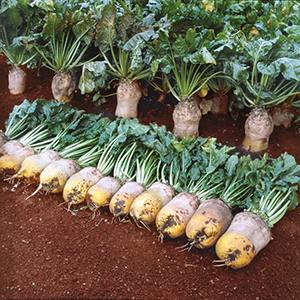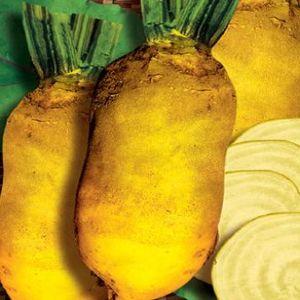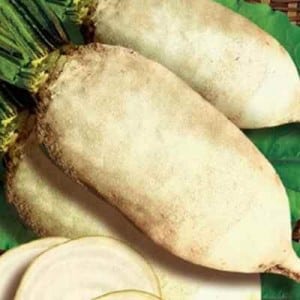Who needs fodder beets and why, how to grow them correctly and can people eat them?
Beetroot is one of the most sought after and popular vegetable crops. Traditionally, table beets, sugar beets and fodder beets are distinguished. The article discusses the main issues related to with cultivation and the use of fodder vegetables.
Description and characteristics of fodder beet
Fodder beet - a technical crop, that is, cultivated for the technical needs of humans. Despite many similarities with other varieties - table and sugar - it differs from them in application and nutritional properties.
The history of the appearance of this beet variety
The Mediterranean and Asia are considered to be the homeland of the vegetable's wild ancestor. As a cultivated plant already in the 8th century BC. e. In the territory of Ancient Babylon, leaf beet was known, the tops of which were used not only for gastronomic, but also for medicinal purposes.
Gradually, the culture spread throughout modern Europe. However, until the 16th century there was no division of beets into table and fodder varieties. Responding to the needs of developing livestock farming, a crop called chard was developed in Germany. The root crop of this close relative of the fodder beet was inedible. In the 17th century, sugar beets were separated from hybrid forms of fodder beet.
Reference! Today there is a huge variety of fodder beet varieties adapted for growing in almost any conditions.
The crop is cultivated in many European countries, North and South America, Australia and New Zealand, and North Africa.
The importance and benefits of fodder beet for animals and birds

Fodder beets play an important role in the nutrition of domestic animals; the entire plant is used for this purpose - both tops and root crops.
It acquires particular importance in the diet of milk-producing livestock - cows and goats. Due to its high fiber content, fodder beet increases milk yield.
The vegetable provides livestock with the necessary energy and nutrients. 1 kg of root vegetable contains:
- 0.11-0.15 g feed units (1 feed unit = 1414 kcal);
- 9 g of digestible protein;
- 0.4 g calcium;
- 0.49 g phosphorus.
The nutritional value of beet tops is even higher (9 g of feed units and 2.1 protein per 1 kg of leaves), so it is an excellent auxiliary feed both fresh and ensiled.
Important! The advantage of beets over other feeds is their high digestibility and ability to improve the absorption of nutrients from other products used in the diet.
As a field crop, fodder beet increases soil fertility and prevents the growth of weeds, and is therefore considered an excellent precursor for grain plants.
For which animals is fodder beet grown?
The vegetable is used to feed various farm animals:
- cows;
- sheep;
- horses;
- pigs;
- rabbits.
Due to its milk-producing properties, fodder beet is most in demand for cow nutrition. However, in order to avoid a decrease in the fat content and taste of milk, the amount of root vegetables eaten per day should not exceed 35 kg.The daily norm of beets for sheep is 5 kg, for horses - about 15 kg, for pigs - at the rate of 7 kg for every 100 kg of animal body weight.
Attention! Piglets are given the vegetable boiled or steamed and added to bran porridge. The rest of the livestock receive raw feed. Root vegetables are crushed immediately before feeding.
Fresh tops are given to goats with the addition of chalk to neutralize the acidity of the food.
Fodder beet growing technology
Growing fodder beets is in many ways similar to cultivating other varieties. However, there are a number of nuances.
Soil requirements
In terms of soil fertility, fodder beet is particularly demanding. Prefers slightly acidic or neutral chernozem with a pH of 6.2-7.5. According to the rules of crop rotation, it grows well on lands previously sown with cereals (wheat, rye) or legumes (corn, peas).
Attention! Beets are not planted in the same area for 2 years in a row.
In preparation for planting, compost or rotted manure, as well as wood ash, are added to the soil as fertilizer. Mineral fertilizers containing phosphorus, nitrogen and potassium are welcome.
Beets love loose soil, so the area should be dug up before planting.
Landing dates and rules
Optimal conditions for planting fodder beets in open ground are usually established in late March - early April.
Landing rules:
- Fodder beets are planted in the ground when the soil temperature reaches +5...+8 °C.
- Pre-treatment of the soil with herbicides is recommended to reduce weed emergence.
- The depth of planting seeds is 3-4 cm. A distance of 40-45 cm is maintained between rows.
- The soil in the beds should be slightly moist, without crust - for this purpose, the crops are broken in.
- The first leaves appear after 8-14 days. Seedlings can survive frosts down to -2 °C.
Reference! In case of early warming, at daytime temperatures of +15...+20 °C, crops can sprout 2-3 days after planting.
Crop care
Agricultural technology for fodder beets does not present any difficulties for gardeners of any level of preparedness:
- To ensure that moisture and air circulate normally in the soil, the soil is loosened 48 hours after planting. In the future, it is necessary to regularly loosen the soil between the rows.
- As soon as the first 2 leaves appear, thinning is performed, leaving the strongest and most viable shoots. The recommended density of fodder beets is no more than 4-5 plants per 1 m2, with a distance between plants of 25 cm. This will ensure healthy growth of root crops.
- After thinning, the plants are fertilized with mineral fertilizers. The procedure is repeated a second time after a month.
- In conditions of insufficient humidity, fodder beets require regular glaze. This is especially critical at the time of thickening of the root crop and growth of young tops.
- Regular weeding is carried out until the beet tops close.
Important! The vegetable does not require lighting and produces rich harvests even in shaded areas.
Diseases and pests
Beets are susceptible to various diseases and pest attacks. To protect the vegetable, preventive maintenance is carried out using mineral fertilizers - nitroammophosphate and potash. To avoid infection with viral and fungal infections, it is recommended to include wood ash in fertilizers.
Among the most common diseases:
- Corneater - occurs as a result of infection of a plant by a complex of pathogens, fungi and bacteria in the soil, less often - in the seed material.As a result, glassy or brown spots and stripes of tissue necrosis appear on the roots. Soon the affected seedlings die before they reach the soil surface.

- Cercospora - a fungal disease manifests itself in the form of small, light-brown, round spots with a red-brown border and a gray velvety coating on the leaves. The disease is unpleasant because it affects the tops, causing the plant to produce new shoots, which consume sugar from the root crops.
- Downy mildew, or downy mildew, appears as a gray-purple fluffy coating on the underside of the leaf. The affected parts of the plant become fragile and die.
- Powdery mildew differs from peronosporosis in the color of the plaque - it is white and forms on both sides of the leaf.
- Fomoz - large light brown spots on the shoots of the plant and dry rot on root crops.
- Rust. Frequent small convex formations of bright yellow or orange appear on the leaves.
- Bacterial spot leaves cause yellowing and subsequently necrosis of the affected organs.
- Mosaic - a virus in which a mesh pattern appears on the leaves interspersed with light green and yellow spots.
Dangerous pests of fodder beet:
- Beet leaf, or bean, aphid damages shoots and transmits viral diseases.
- Beet bug sucks the juice from the leaves, leaving behind transparent spots on the tops, then blackening and deformation of the tops. Causes plant development to lag.
- Common and gray beet weevils eat lateral roots and damage the root crop, cause developmental disorders, reducing the weight and sugar content of the vegetable.
- Beet flea beetles They eat out small pits and through holes in the leaves, and gnaw on the apical bud.
- Beet flies, the larvae of which severely damage the tops, leading to their withering and death.
To combat pests, industrial protection products “Samurai Super”, “Bi-58”, “Karbofos-500”, “Decis Pro” are used.
Harvest and storage
Signs of vegetable ripening:
- yellowed leaves against the background of the plant’s lack of new tops;
- the root crop reaches a diameter characteristic of a particular variety.
During the period of accumulation of dry matter by the root crop (a month before harvesting), watering is stopped.
It is important to harvest before the first frosts and prolonged rains to prevent spoilage of the root crop (this shortens the shelf life of the beets). Depending on the region, the collection is scheduled for early September, October or even November.
Reference! To collect fodder beets, potato diggers, potato harvesters or beet lifters are used. When harvesting by hand, root crops are dug up with a pitchfork.
To ensure longer storage, the tops are removed and the root crops are cleaned of adhering soil. The vegetables are lightly dried and sorted.
Important! Damaged specimens and cut tops are used as animal feed first.
Store beets in piles or other storage facilities with ventilation and maintained at a temperature of 1 to 5 °C.
Yield of fodder beet per 1 ha
In terms of yield, fodder beets are superior to table and sugar beets. With proper care per hectare of plantings, you can collect 900-1100 centners of root crops and tops. Such indicators are achieved due to the relative unpretentiousness of the vegetable and its resistance to adverse environmental conditions.
The most common types and varieties of fodder beets
When choosing seeds for planting, gardeners give preference to the following varieties and hybrids:
- Brigadier - mid-season variety, resistant to flowering, drought and frost (withstands temperatures down to -5 ° C). Small (weighing about 3 kg) orange-green root vegetables have an oval-cylindrical shape and contain a lot of sugar. Productivity - 150 t/ha.

- Lada - a variety resistant to drought and disease both during growth and during storage. The weight of the white (sometimes pinkish-white) cylindrical root crop reaches 25 kg. It has juicy, dense pulp. The average yield is 120 t/ha.
- F1 Milan - a hybrid resistant to flowering and cercospora. Suitable for different types of soil, has a long shelf life. It has a white-green oval root crop of medium size. Productivity - 90 t/ha.
- Hope. Due to its unpretentiousness, the variety is especially widespread in the Northwestern, Middle Volga and Far Eastern regions of Russia. The root vegetable is red, cylindrical in shape, with white juicy pulp. Resistant to infection by powdery mildew and cercospora. Has high productivity.
- Ursus Poli interesting for the unusual color of the root vegetable - yellow-orange, cylindrical in shape, weighing up to 6 kg. Drought-resistant, not prone to flowering. Other advantages include long-term storage and disease resistance. Productivity - 125 t/ha.
- Centaur Poly has small (weighing 1.5-2.5 kg) white root vegetables, elongated oval in shape. The variety demonstrates resistance to cercospora and bolting, as well as drought. Productivity - 100-110 t/ha.
- Yellow Eckendorf not sensitive to low temperatures, suitable for planting in open ground on a personal plot.
Can people eat fodder beets?
In terms of nutritional value, fodder beets are not inferior to their counterparts. The main gastronomic difference is the high fiber content and coarse fibers, which are poorly digested by the human gastrointestinal system.
The root vegetable is inconvenient for use in cooking, as it requires long-term heat treatment. In terms of taste, it is significantly inferior to table beet and sugar beet.
What is the difference between fodder beet and sugar beet?
Sugar beets are the result of selection of a fodder variety, but they differ from their predecessors in many respects:
- Growing conditions: Fodder beets are not planted in gardens; they are usually cultivated on an industrial scale. Unlike sugar, it grows successfully in the climatic conditions of northern latitudes.
- Appearance: sugar varieties have elongated leaves and a more powerful root system, most often - conical roots that are exclusively white. Fodder beet has darker, smoother and shiny heart-shaped leaves - you can distinguish them from the photo. Root vegetables come in a variety of varieties shapes and colors.
- Purpose: sugar is used to produce sugar; only the leaves are used for feed. Fodder beets are used entirely as food for domestic animals.
- Nutritional properties: in sugar beets the amount of sucrose is 20% higher. The energy value of feed is lower, but it contains more protein.
All varieties differ in turn from table beets, which are used for food.
Conclusion
Fodder beet is a popular and unpretentious agricultural crop.Due to the increased content of easily digestible carbohydrates, it promotes milk production and improves its quality, therefore it is especially important in the diet of milk-producing animals, primarily cows.
If the timing of planting and harvesting, basic rules of agricultural technology and the reasonable use of organic and mineral fertilizers are observed, fodder beet produces a consistently high yield. Among the disadvantages of the vegetable are its demands on the soil, the forced change of growing location every season and the need for regular watering and fertilizers.